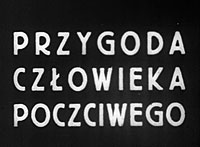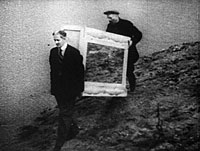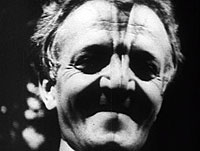 Przygoda człowieka poczciwego
Przygoda człowieka poczciwego
Poland, 1937, black and white, 10 mins
The last of five films made by the husband-and-wife team of Franciszka and Stefan Themerson in their native Poland, The Adventure of a Good Citizen is the only one to have survived World War II – indeed, it’s one of the few remaining examples of what by all accounts was a thriving 1930s Polish avant-garde in which the Themersons played a leading role as both artists, promoters and critics (they ran a film production cooperative, SAF, and a short-lived avant-garde film magazine, f.a.) . Unlike most of their films, it’s almost entirely live action, albeit replete with various in-camera effects, including so much reverse motion that Stefan Themerson claimed that the film would make just as much sense if run backwards – at least visually, if not aurally.

An opening title characterises the film as “an irrational humoresque”, while cautioning the viewer “not to misinterpret [the protagonist’s] lyrical flight from reality for nonsensical extravagance.” In other words, for all the film’s playfulness (the opening shot is of a drummer drumming on what a pan reveals to be a hat worn by a distinctly unamused man) and Stefan Kisielewski’s jolly score, there’s method in the Themersons’ apparent madness. Indeed, the film’s plea for tolerance of individual eccentricity comes across as being far more poignant today, in light of what happened in Poland just two years after the film was completed.
There are two parallel narratives – in one, two men attempt to carry a large wardrobe with a mirrored front (it is generally assumed that Roman Polański must have seen this film during his studies at the Łódź Film School, as there are many visual and thematic parallels between it and his 1958 film Two Men and a Wardrobe/Dwaj ludzie z szafą), while in the other, an office worker (the ‘Good Citizen’ of the title) overhears instructions being given to one of the wardrobe-carriers – “The sky won’t fall in if you walk backwards!” – and decides to adopt it as his personal credo. So while the wardrobe is being transported, the Good Citizen gingerly tries walking backwards out of his office and then, with greater confidence, out into the world. One minor accident later (which results in the Good Citizen assisting with the wardrobe transportation), and he’s the target of a full-scale protest march, with placards reading ‘Down With Walking Backwards!’.

When the wardrobe-carriers enter the forest, there’s a startlingly lyrical interlude making use of Stefan Themerson’s trademark ‘photogram’ technique, in which objects were filmed through a translucent glass sheet covered with paper to create highly expressive silhouetted effects of a bird, plants, lights and indefinable abstract movements (this section was originally hand-coloured). After this, the wardrobe becomes the central prop for a variety of fantastical ideas in which the men seem to fly (by means of flapping one arm and leg next to the wardrobe’s mirror, creating the impression that they’re taking off – a visual gag later trademarked by the British comedian Harry Worth). When the protestors finally track them down, the men have genuinely taken off into the sky, and the wardrobe stands empty.

The film’s recurring themes of flight, reverse motion and the undermining of what are perceived to be natural laws are echoed by the visual and montage treatment. Much use is made of the wardrobe mirror to play tricks with reflections on camera, but photographic effects are also used – in an early sequence, people appear to turn left and right simultaneously, their “reflections” appearing in negative form. The mirror not only seems to reflect the world in the conventional way, but it also occasionally seems to make time run backwards: its attitude towards spatial and temporal laws seems just as cavalier as does the Good Citizen’s, and indeed the Themersons themselves. It’s an authentically Surrealist film up to a point (and would play well in a programme with other 1920s/30s examples of the form such as Fernand Léger’s Ballet Mécanique, Man Ray’s films or Luis Buñuel and Salvador Dalí’s Un Chien Andalou), but it also conveys a forceful message about freedom and individuality, albeit couched in much more playful terms than the Themersons’ next film, the despairing anti-Nazi propaganda film Calling Mr. Smith (1944).
- Directors: Franciszka and Stefan Themerson
- Script: Franciszka and Stefan Themerson
- Photography: Franciszka and Stefan Themerson
- Music: Stefan Kisielewski
DVD Distribution: The Adventure of a Good Citizen is included in the DVD compilation The Films of Franciszka and Stefan Themerson (Region 0 PAL), a collaboration between LUX in London and Polish Audiovisual Publishers (Polskie Wydawnictwo Audiowizualne/PWA) in Poland.
Picture: This is sourced from the only surviving copy, a 16mm dupe of a 35mm original, so any issues regarding image quality and physical condition should be set against the print’s extreme rarity value. Actually, it’s surprisingly watchable – there are a few splices, but no more serious damage bar a few spots, scratches and faint tramlines, and though the grain and contrast are certainly more obtrusive than intended, they’re never actively destructive (though the hand-tinted colours that originally accompanied part of the forest scene have not survived). It’s hard to see how the DVD transfer could have done a better job with this material.
Sound: With the caveat that this is a mid-1930s soundtrack (with all that that implies in terms of inescapable technical limitations), it really doesn’t sound at all bad. Music and dialogue are perfectly clear, and although there’s some faint crackle in the background, it’s much less obtrusive than one might expect.
Subtitles: These alternate between yellow (over titles) and white (over moving images), but the translation seems fine, and they’re sensitively placed – on the left-hand side of the framt to avoid obscuring a sign, for instance. They’re also optional, and barely needed, so they can easily be switched off after a first viewing.
Links
- Luxonline page for The Adventure of a Good Citizen (includes video clip)
- The Themerson Archive (official website)
- Gaberbocchus Press (official website)
- Stefan and Franciszka Themerson (Luxonline – includes links to video excerpts)
- Luxonline articles: Franciszka and Stefan Themerson (Jasia Reichardt/Nick Wadley), The Films of Stefan and Franciszka Themerson (Marcin Giżycki), The Themersons and the Polish Avant-Garde (A.L.Rees)
- Wikipedia entries on Stefan and Franciszka Themerson.